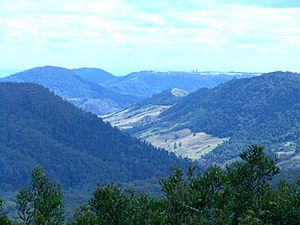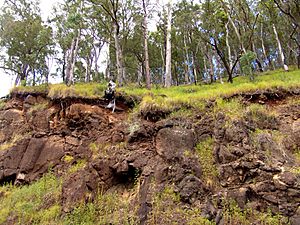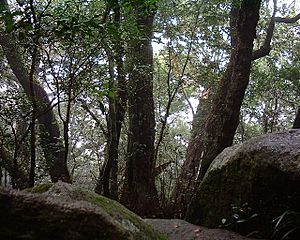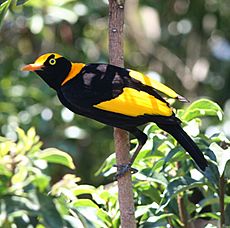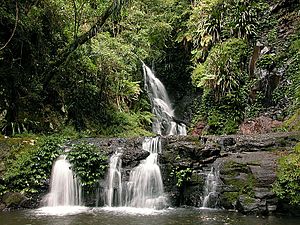Lamington National Park facts for kids
Quick facts for kids Lamington National ParkQueensland |
|
|---|---|
|
IUCN Category II (National Park)
|
|
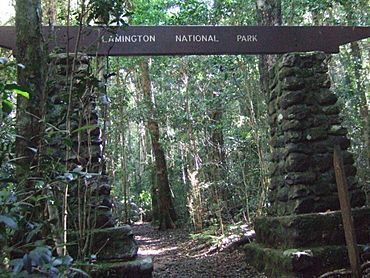
Entrance to the trail network at Binna Burra
|
|
| Nearest town or city | Canungra |
| Established | July 1915 |
| Area | 206 km2 (79.5 sq mi) |
| Managing authorities | Queensland Parks and Wildlife Service |
| Website | Lamington National Park |
| See also | Protected areas of Queensland |
Lamington National Park is a special place in Australia. It's a national park located on the Lamington Plateau. This plateau is part of the McPherson Range, right on the border between Queensland and New South Wales.
The park is about 85 kilometers (53 miles) southwest of Southport on the Gold Coast. It's also about 110 kilometers (68 miles) north of Brisbane. Lamington National Park covers a huge area of 20,600 hectares (50,900 acres). It's famous for its amazing nature, including lush rainforests, many different kinds of birds, very old trees, beautiful waterfalls, and exciting walking trails with great mountain views.
Nearby protected areas, like Springbrook National Park and Border Ranges National Park, also have similar landscapes. Lamington National Park is part of the Gondwana Rainforests of Australia. This is a World Heritage Site recognized in 1986. It was also added to the Australian National Heritage List in 2007. The park is also part of the Scenic Rim Important Bird Area. This means it's super important for protecting several threatened bird species.
In 2009, Lamington National Park was named one of the Q150 Icons of Queensland. This was part of the state's 150th birthday celebrations. It was recognized for being a top "Natural attraction."
Contents
Exploring Lamington's Geography
Most of Lamington National Park sits about 900 meters (2,950 feet) above sea level. It's only about 30 kilometers (19 miles) from the Pacific Ocean. The plateaus and cliffs you see in Lamington and Springbrook National Parks are what's left of a giant volcano. This volcano was active about 23 million years ago. Its center was around Mount Warning.
Some parts of the park in the south are over 1,000 meters (3,280 feet) high. The land slopes down to less than 700 meters (2,300 feet) in the north. Important mountains in the park include Mount Hobwee, Mount Widgee, Mount Toolona, Mount Cominan, Mount Roberts, and Mount Bithongabel. These mountains are home to some of Australia's rare cloud forests.
Several rivers start in Lamington National Park. These include the Nerang River, Albert River, and Coomera River. The eastern parts of the park have tall cliffs that overlook the Numinbah Valley. The park is located within the City of Gold Coast and Scenic Rim Region areas.
A Glimpse into Lamington's History
Aboriginal people have lived in and visited these mountains for at least 6,000 years. The Wangerriburras and Nerangballum tribes considered this plateau their home. About 900 years ago, the number of Aboriginal people in the area started to decrease.
Bushrangers Cave, which is near Mount Hobwee, is 60 meters (200 feet) long. It was once an Aboriginal camp. Evidence shows that Aboriginal people lived here as far back as 10,000 years ago.
The first European explorers to visit the area were Captain Patrick Logan and Allan Cunningham. After them came timber cutters, who cut down trees for wood. The Lahey family, who owned one of Queensland's biggest timber mills, was among them. In 1863, surveyors defined the border between Queensland and New South Wales. They had to find the highest points in thick rainforest, which was a very difficult task.
Robert Collins worked hard to protect the area from logging in the 1890s. He became a politician and helped pass a law to save state forests and national parks. However, he passed away before the McPherson Range was fully protected. Later, another local person, Romeo Lahey, understood how important it was to save these forests. He campaigned to make it one of Queensland's first protected areas.
Lamington National Park was officially created in 1915. It was named after Lord Lamington, who was the Governor of Queensland from 1896 to 1902. The O’Reilly family opened a guesthouse near the park in 1926. Today, it's known as O'Reilly's Rainforest Retreat. In the 1930s, people who started the National Parks Association of Queensland built Binna Burra Lodge next to the park.
In 1937, Bernard O'Reilly became a hero. He rescued people who survived a plane crash in the remote Lamington wilderness. An Airlines of Australia Stinson Model A plane, called City of Brisbane, had crashed. Bernard O'Reilly, like a true Australian bushman, went on his rescue mission with only onions and bread to eat. Today, only a small part of the original plane wreck remains. It's about 10 kilometers (6.2 miles) south of O'Reilly's guesthouse.
Lamington's Amazing Natural Heritage
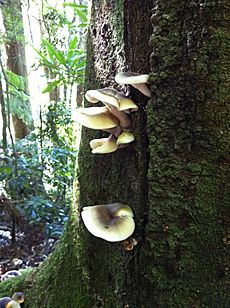
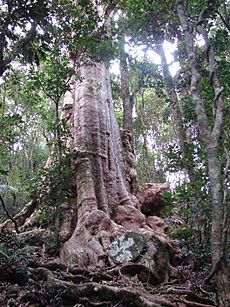
Lamington National Park protects a stunning natural environment. It features rugged mountains, many waterfalls, interesting caves, dense rainforests, wildflower heaths, and tall open forests. There are also clear creeks and a wide variety of wildlife. The park offers some of the best bushwalking trails in Queensland. It is the main part of the Central Eastern Rainforest Reserves Australia World Heritage Area. This area also includes the nearby Border Ranges National Park in New South Wales.
The famous naturalist David Attenborough visited and filmed in the park. He featured its beech trees and bowerbirds in his 1979 television series Life on Earth.
Diverse Plant Life (Flora)
Lamington National Park is home to an incredible variety of plants. Its lush rainforests include one of the largest remaining subtropical rainforests in the world. It also has the most northern Antarctic beech cool temperate rainforests in Australia. The roots of the oldest Antarctic beech trees are over 5,000 years old! Around Mount Widgee, the number of Antarctic beech trees seems to be growing. The park also protects one of Australia's largest remaining forests of hoop pine (Araucaria cunninghamii). These pines are found on the drier slopes.
Below 880 meters (2,890 feet), you can often find white booyong and black booyong trees. At higher elevations, trees like the yellow carabeen, red carabeen, pigeonberry ash, rosewood, and soft corkwood are common.
Many plants in Lamington are found nowhere else on Earth. Examples include O’Reilly's pittosporum (Pittosporum oreillyanum) and the Lamington peach myrtle (Uromyrtus lamingtonensis). The Mt Merino eyebright and Everlasting Daisy are subalpine plants left over from the last ice age.
In 2006, scientists realized that an old sample of the eastern underground orchid (Rhizanthella slateri) from Lamington was actually a new species. It was named the Lamington underground orchid (Rhizanthella omissa). This orchid, like its relatives, has no chlorophyll. This means it depends entirely on a symbiotic fungus to survive. It's also one of only four flowering plants on Earth that completes its entire life cycle underground.
Sadly, one of Lamington's more than 100 fern species is now thought to be extinct. This fern, Antrophyum austroqueenslandicum, was known from only one plant that has since died. No other plants have been found. Lamington also protects many threatened plant species, such as the ravine and blotched Sarchochilus orchids. You can also find Strangler figs in Lamington.
Amazing Animal Life (Fauna)
Lamington is one of the most important places for wildlife in the region. It's home to an incredible variety of animals. This includes rare and threatened animals like the Coxen's fig parrot, eastern bristlebird, Albert's lyrebird, and Richmond birdwing butterfly.
The blue Lamington crayfish lives only on the Lamington plateau. You can find it in pools and streams above 450 meters (1,480 feet) elevation. When it's damp, they can also move around on the forest floor. The large-eared pied bat, which is a vulnerable species, also lives in the park.
Other rare animals include the rainforest cool-skink and elf skink. Many frog species live here too, such as the Fleay's barred frog, giant barred frog, and the cascade treefrog. You might see Red-necked pademelons near the edges of the rainforest. Platypus can sometimes be spotted in the deeper rock pools. The beautiful regent bowerbird and the colorful crimson rosella are often seen in Lamington.
Understanding Lamington's Geology
Lamington National Park is on the northern side of the Tweed volcano. This huge shield volcano is over 100 kilometers (62 miles) wide. It stretches from Tamborine Mountain in the north to Lismore in the south. The volcanic plug of Mount Warning marks the very center of this ancient volcano.
This volcano was active about 23 million years ago. At that time, this part of Australia was above a hotspot in the Earth's mantle. Both basaltic and rhyolitic lavas erupted from the volcano. Over millions of years, rain and running water have eroded these lavas. This erosion created the many amazing landforms you see in the park today, including its famous cliffs.
Below these lava layers is a layer of tuff. Tuff is made from volcanic ash and fine rock. In some places, this layer can be up to 60 meters (200 feet) thick. The basalt rocks of the Lamington Plateau came from the Focal Point volcano. Near Binna Burra, the basalt layer is estimated to be as thick as 700 meters (2,300 feet).
Discovering Lamington's Waterfalls
The park is home to more than 500 waterfalls! Some of these include Elabana Falls and Running Creek Falls. Running Creek Falls, in the south of the park, flows into a box canyon. Yarrbilgong Falls and Coomera Falls both flow into Coomera Gorge.
Morans Falls is another beautiful cascade. You can see it on the 6-kilometer (3.7-mile) Morans Falls Track. Other waterfalls in the national park include Nugurun Falls, Box Log Falls, Upper Ballanjui Falls, Lower Ballanjui Falls, Stairway Falls, and Nagarigoon Falls.
Bushwalking Adventures in Lamington
Lamington National Park has over 150 kilometers (93 miles) of clearly marked walking trails. These trails were built during the Great Depression and designed by Romeo Lahey. Lahey studied how dairy cows moved on the hills. He noticed their paths were never steeper than a 1:10 gradient. He designed the park's tracks in a similar way so that walkers wouldn't get out of breath. Where steep ground couldn't be avoided, steps were built instead of a steep path.
Some walks are short, while others are steep and can take up to seven hours to finish. The well-kept and signed Border Track follows the border between New South Wales and Queensland. It runs along the top of the McPherson Range. This track connects Binna Burra Lodge to the O'Reilly's guesthouse at Green Mountains. It's about 23 kilometers (14 miles) long and can be walked in one day, taking 7 to 8 hours.
Many other well-marked walks connect to the Border Track. This creates a network that even less experienced bushwalkers can enjoy. Some popular ones include the Box Forest Circuit, which is 10.9 kilometers (6.8 miles) and takes 4 hours return from O'Reilly's. The Toolona Creek Circuit is 17.4 kilometers (10.8 miles) and takes 6 hours return. The Albert River Circuit is 20.6 kilometers (12.8 miles) and takes 7 hours return to O'Reilly's. While the Border Track stays fairly level, many other tracks go down to lower elevations of 750 meters (2,460 feet) or less. These lower paths let you see more of the park's diverse plants, animals, and landscapes.
Another exciting attraction is the Tree Top Walk. This walk is suspended 15 meters (49 feet) above the ground. It lets you safely walk through the canopy of the forest on a series of suspension bridges. You can even climb a ladder up a strangler fig tree to an observation deck 30 meters (98 feet) above the ground!
For experienced walkers, there are also many challenging trails. These trails don't have clear paths; sometimes there are only occasional markers in the natural forest. It's not a good idea to use them unless you are with an experienced bushwalker who knows the area well. The walk to the Stinson plane wreck is long and steep in some places. You need good map reading and navigation skills for these trails. You should also tell the National Park Rangers before you start. Camping overnight is only allowed with a permit. Bushwalkers should also be aware of natural hazards like leeches, snakes, and stinging trees.
Staying in Lamington National Park
Besides the guesthouses, there's also a campground in the Green Mountains section of the park. It's right next to the O'Reilly's guesthouse. There's also a privately managed campground next to the Binna Burra section of the park. Both camping areas have facilities like toilets and showers. You can also do limited bush camping (camping in the wilderness) between February and November, but you need a permit.
Images for kids
See also
 In Spanish: Parque nacional Lamington para niños
In Spanish: Parque nacional Lamington para niños



